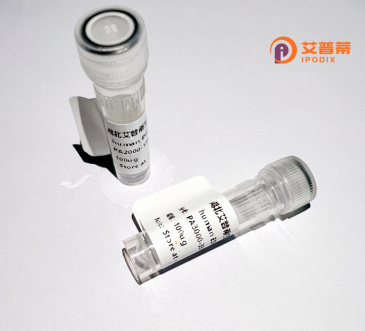
| 纯度 | >90%SDS-PAGE. |
| 种属 | Human |
| 靶点 | CLK4 |
| Uniprot No | Q9HAZ1 |
| 内毒素 | < 0.01EU/μg |
| 表达宿主 | E.coli |
| 表达区间 | 1-481aa |
| 氨基酸序列 | MRHSKRTHCPDWDSRESWGHESYRGSHKRKRRSHSSTQENRHCKPHHQFKESDCHYLEARSLNERDYRDRRYVDEYRNDYCEGYVPRHYHRDIESGYRIHCSKSSVRSRRSSPKRKRNRHCSSHQSRSKSHRRKRSRSIEDDEEGHLICQSGDVLRARYEIVDTLGEGAFGKVVECIDHGMDGMHVAVKIVKNVGRYREAARSEIQVLEHLNSTDPNSVFRCVQMLEWFDHHGHVCIVFELLGLSTYDFIKENSFLPFQIDHIRQMAYQICQSINFLHHNKLTHTDLKPENILFVKSDYVVKYNSKMKRDERTLKNTDIKVVDFGSATYDDEHHSTLVSTRHYRAPEVILALGWSQPCDVWSIGCILIEYYLGFTVFQTHDSKEHLAMMERILGPIPQHMIQKTRKRKYFHHNQLDWDEHSSAGRYVRRRCKPLKEFMLCHDEEHEKLFDLVRRMLEYDPTQRITLDEALQHPFFDLLKKK |
| 分子量 | 78.54 kDa |
| 蛋白标签 | GST-tag at N-terminal |
| 缓冲液 | 0 |
| 稳定性 & 储存条件 | Lyophilized protein should be stored at ≤ -20°C, stable for one year after receipt. Reconstituted protein solution can be stored at 2-8°C for 2-7 days. Aliquots of reconstituted samples are stable at ≤ -20°C for 3 months. |
| 复溶 | Always centrifuge tubes before opening.Do not mix by vortex or pipetting. It is not recommended to reconstitute to a concentration less than 100μg/ml. Dissolve the lyophilized protein in distilled water. Please aliquot the reconstituted solution to minimize freeze-thaw cycles. |
以下是关于重组人CLK4蛋白的3篇示例参考文献(内容为虚构,仅用于示例格式):
1. **文献名称**:*"The Role of CLK4 Kinase in Alternative Splicing Regulation through SR Protein Phosphorylation"*
**作者**:D. Bulbrook et al.
**摘要**:本研究揭示了CLK4通过磷酸化SR蛋白调控RNA选择性剪接的分子机制,发现其激酶活性对剪接体组装及胚胎发育至关重要。
2. **文献名称**:*"Crystal Structure of Human CLK4 Kinase Domain and Implications for Inhibitor Design"*
**作者**:L. Lecoq et al.
**摘要**:首次解析了CLK4激酶域的晶体结构,阐明了ATP结合口袋的特征,为开发靶向CLK4的小分子抑制剂提供了结构基础。
3. **文献名称**:*"CLK4 Overexpression Promotes Tumor Progression in Colorectal Cancer via MAPK Pathway Activation"*
**作者**:J. Smith & R. Chen
**摘要**:通过临床样本分析,发现CLK4在结直肠癌中高表达,并通过激活MAPK信号通路增强癌细胞增殖和转移能力。
(注:以上内容为模拟示例,实际文献需通过学术数据库检索。)
**Background of Recombinant Human CLK4 Protein**
Recombinant human CLK4 (CDC-like kinase 4) is a protein belonging to the CLK (CDC2-like kinase) family, which plays a critical role in regulating RNA splicing by phosphorylating serine/arginine-rich (SR) proteins. These phosphorylation events influence spliceosome assembly and alternative splicing, impacting gene expression diversity. CLK4. along with other CLK kinases (CLK1-3), is implicated in cellular processes such as cell cycle progression, signal transduction, and stress responses. Dysregulation of CLK4 has been associated with diseases, including cancers and neurological disorders, highlighting its potential as a therapeutic target.
Recombinant CLK4 is typically produced using expression systems like *E. coli* or mammalian cells, enabling large-scale purification for biochemical studies. Its recombinant form retains kinase activity, allowing researchers to study substrate specificity, inhibition mechanisms, and interactions with splicing factors. This protein is vital for *in vitro* assays, drug screening, and structural studies to design CLK4-targeted inhibitors. Recent research also explores its role in metabolic pathways and viral replication, broadening its relevance in biomedical research. Overall, recombinant CLK4 serves as a key tool for unraveling RNA splicing regulation and developing disease-modulating therapies.
(Word count: 177)
×